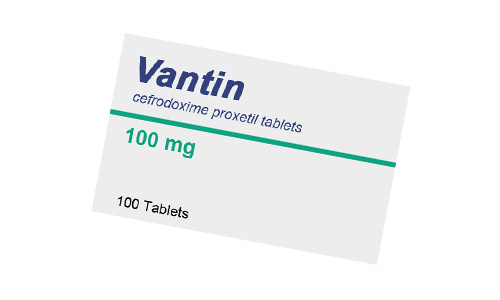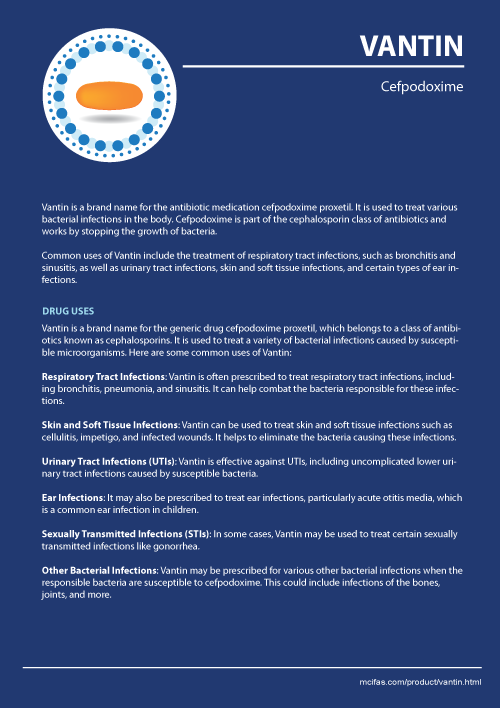Vantin Prescribing Information
Vantin is a brand name for the antibiotic medication cefpodoxime proxetil. It is used to treat various bacterial infections in the body. Cefpodoxime is part of the cephalosporin class of antibiotics and works by stopping the growth of bacteria.
Common uses of tis drug include the treatment of respiratory tract infections, such as bronchitis and sinusitis, as well as urinary tract infections, skin and soft tissue infections, and certain types of ear infections.

Uses of Vantin
Vantin is a brand name for the generic drug cefpodoxime proxetil, which belongs to a class of antibiotics known as cephalosporins. It is used to treat a variety of bacterial infections caused by susceptible microorganisms. Here are some common uses:
- Respiratory Tract Infections: Antibiotic is often prescribed to treat respiratory tract infections, including bronchitis, pneumonia, and sinusitis. It can help combat the bacteria responsible for these infections.
- Skin and Soft Tissue Infections: Vantin can be used to treat skin and soft tissue infections such as cellulitis, impetigo, and infected wounds. It helps to eliminate the bacteria causing these infections.
- Urinary Tract Infections (UTIs): Medicine is effective against UTIs, including uncomplicated lower urinary tract infections caused by susceptible bacteria.
- Ear Infections: It may also be prescribed to treat ear infections, particularly acute otitis media, which is a common ear infection in children.
- Sexually Transmitted Infections (STIs): In some cases, Vantin may be used to treat certain sexually transmitted infections like gonorrhea.
- Other Bacterial Infections: Cefpodoxime may be prescribed for various other bacterial infections when the responsible bacteria are susceptible to cefpodoxime. This could include infections of the bones, joints, and more.
Dosage
The dosage of Vantin can vary depending on the type and severity of the infection, as well as individual factors such as age, weight, and kidney function. Do not adjust the dosage on your own, and complete the full course of treatment even if you start feeling better before it's finished. Stopping antibiotics prematurely can lead to antibiotic resistance.
Here are general guidelines for Vantin dosages:
Adults and Adolescents (12 years and older):
- For mild to moderate infections: The typical dosage is 100 mg to 200 mg taken orally every 12 hours.
- For more severe infections: The dosage may be increased to 400 mg taken orally every 12 hours.
Children (Under 12 years):
- The dosage for children is based on their weight.
Duration: The duration of treatment can vary depending on the type of infection. Treatment typically lasts 7 to 14 days.
It's important to complete the entire course of antibiotics as prescribed, even if your symptoms improve before the medication is finished. If you miss a dose, take it as soon as you remember. However, if it's close to the time for your next dose, skip the missed dose and continue with your regular dosing schedule.
Side Effects of Vantin
Vantin is generally well-tolerated, but like all medications, it can have side effects. Not everyone will experience these side effects, and some people may experience them to a greater degree than others. Common side effects may include:
Gastrointestinal Disturbances: These are among the most common side effects and can include:
- Nausea
- Vomiting
- Diarrhea
- Stomach pain or discomfort
Headache: Some individuals may experience headaches while taking Vantin.
Skin Rash: Skin reactions, including rashes, itching, or hives, can occur in some cases.
Vaginal Yeast Infection: Women may be more prone to developing vaginal yeast infections while taking antibiotics.
Changes in Taste: Rarely, people may report alterations in their sense of taste.
Dizziness: Some individuals may experience dizziness.
Fatigue: Feeling tired or fatigued is a less common side effect.
Fever: An elevated body temperature may occur in some cases.
Joint Pain: Joint pain has been reported in rare instances.
Allergic Reactions: While uncommon, severe allergic reactions can occur. Seek immediate medical attention if you experience symptoms like difficulty breathing, swelling of the face, lips, tongue, or throat, or severe skin reactions.
Interaction with other drugs
Drug interactions can vary depending on the specific medications involved and individual factors.
Here are some examples of medications that may interact with Vantin:
- Antacids: Antacids containing aluminum or magnesium can reduce the absorption of Cefpodoxime if taken at the same time. It's advisable to separate the administration of Vantin and antacids by at least 2 hours.
- Probenecid: Probenecid may increase the blood levels of Vantin by reducing its elimination from the body. This can lead to an increased risk of side effects.
- Oral Contraceptives: There is a potential for decreased effectiveness of hormonal birth control methods (e.g., birth control pills) when taken with antibiotics. It's recommended to use alternative or additional forms of contraception while on antibiotics and for a period afterward.
- Blood-Thinning Medications (Anticoagulants): Cefpodoxime, the active ingredient in Vantin, can potentially enhance the effects of blood-thinning medications like Warfarin. Close monitoring of blood clotting parameters may be necessary.
- Other Antibiotics: Taking multiple antibiotics at the same time can increase the risk of side effects and potentially reduce their effectiveness.
- Certain Vaccines: Antibiotic may reduce the effectiveness of live bacterial vaccines.
- Other Drugs: Various other medications may interact with Vantin, including drugs used to treat gout, certain diuretics, and more.
What to avoid while on Vantin
While taking Vantin, there are certain things you should avoid or be cautious about to ensure the medication's effectiveness and minimize the risk of side effects. Here are some general recommendations:
- Alcohol: It's generally advisable to limit or avoid alcohol while taking antibiotics. Alcohol can interact with the medication and potentially increase the risk of side effects, such as gastrointestinal upset.
- Antacids and Minerals: Avoid taking antacids or mineral supplements that contain aluminum, magnesium, or iron within 2 hours before or after taking Vantin. These substances can interfere with the absorption of the antibiotic.
- Dairy Products: While not a strict restriction, some people find that dairy products can reduce the absorption of Cefpodoxime. If you experience stomach upset or reduced effectiveness, consider taking the medication with water instead of milk.
- Sun Exposure: Vantin itself does not typically cause increased sensitivity to sunlight. However, if you experience a skin rash or other skin reactions while taking it, it's advisable to avoid prolonged sun exposure and use sunscreen to protect your skin.
- Birth Control Pills: If you are using hormonal birth control methods like birth control pills, their effectiveness may be reduced while taking tablets. Consider using alternative or additional forms of contraception during antibiotic treatment and for a period afterward.
- Other Medications: Be cautious with any other medications you are taking.
- Driving and Operating Machinery: Vantin is not known to cause significant drowsiness or impair cognitive function in most people. However, individual reactions can vary. If you experience dizziness or other side effects that affect your ability to drive or operate machinery, avoid these activities until you feel safe to do so.
Contraindications of Vantin
Vantin may not be suitable for everyone, and there are certain contraindications or conditions under which it should not be used. Here are some contraindications for Vantin:
- Allergy to Cefpodoxime or Cephalosporin Antibiotics: If you have a known allergy to cefpodoxime, other cephalosporin antibiotics, or related antibiotics like penicillins, you should not take Vantin. Allergic reactions can be severe and life-threatening.
- History of Severe Allergic Reactions: If you have a history of severe allergic reactions (anaphylaxis) to any medications, especially antibiotics, you should avoid Vantin.
- Clostridium difficile Infection (C. difficile): Vantin can sometimes lead to the overgrowth of a bacteria called Clostridium difficile. If you have a known or suspected C. difficile infection or a history of this infection, Vantin should be avoided.
- Certain Gastrointestinal Conditions: People with a history of colitis or other gastrointestinal disorders should use Vantin with caution, as it can exacerbate these conditions.
- Severe Renal Impairment: In individuals with severely impaired kidney function, the dosage of Vantin may need to be adjusted, or an alternative antibiotic may be recommended.
- Pediatric Age and Low Body Weight: Medicine should be used with caution in infants and very young children, particularly those with low body weight, as dosing may need adjustment.
- Liver Disorders: People with severe liver disorders should use Vantin with caution, as it may require dose adjustments.
Pregnancy and Vantin
Pregnant women should use antibiotics with caution, and its use during pregnancy should only be considered when the potential benefits outweigh the potential risks. Here's some information about Vantin and pregnancy:
- Pregnancy Category B: Vantin is classified as a Pregnancy Category B medication by the U.S. Food and Drug Administration (FDA). This means that animal studies have not shown any adverse effects on fetal development, but there are limited human studies available. It suggests that Vantin may be relatively safe to use during pregnancy when deemed necessary.
- Breastfeeding: Small amounts of cefpodoxime, the active ingredient in Vantin, may pass into breast milk.
» Drug Uses (format pdf, 0.2 Mb)



